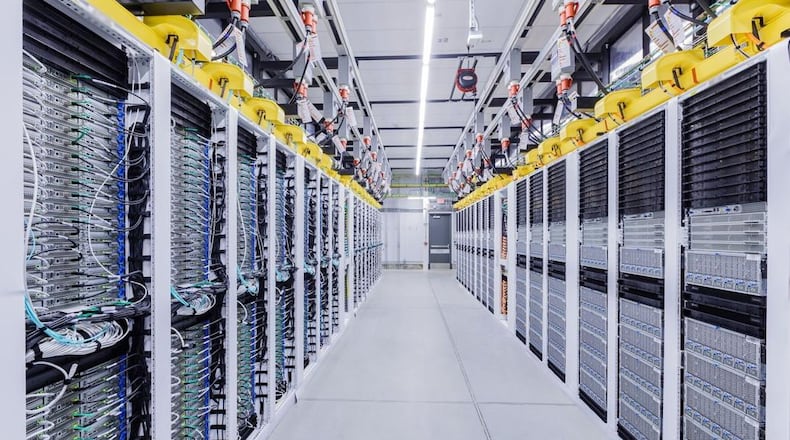A proposal for an expansive data center campus in Bartow County is poised to become one of the area’s biggest projects — and largest electricity users.
Preliminary plans for “Project Springbank” were disclosed Friday for a six-building data center campus an hour northwest of Atlanta, according to a Development of Regional Impact filing. Each computer storage warehouse within the $4.5 billion project is envisioned to span 379,000 square feet and could use up to 78 megawatts of electricity.
A single megawatt is enough to power about 750 homes. At a total capacity of 432 megawatts, the project as proposed would use as much power as about 324,000 houses. That’s nearly seven times the number of housing units currently in Bartow County, according to U.S. Census data.
The gigantic proposal joins a wave of other data center projects — some speculative and others with firm industry backing — in development across metro Atlanta as the country rushes to build more computer server storage space.
Project Springbank is being pitched by Atlas Development LLC, the same relatively unknown company behind the eye-popping $17 billion “Project Sail” data center proposal in Coweta County, which was made public on New Year’s Eve. The company, which state records show was founded in 2017 in Whitesburg, did not immediately respond Monday to a request for comment.
Both projects are in preliminary planning stages and would require zoning changes to move forward. There also isn’t any indication that a major data center operator is tied to either project.
Pete Marin, CEO of Buckhead-based data center developer T5, has four data center campuses in the Atlanta area that are either operational or in development. He said the rampant demand for server storage farms has prompted upstarts to try to enter the data center sector alongside established industry stalwarts, which he believes has skewed electricity projections that state regulators and utilities rely on to forecast demand for Georgia’s power grid.
“There’s a lot of groups that are jumping into the data center business that have not been in it before,” Marin said in an interview last week. “When I look at demand forecasts, my view is it’s overstated because the number of investors are chasing the same opportunity, and they don’t have the track record like what we have at T5.”
Credit: Courtesy Bartow County
Credit: Courtesy Bartow County
Brandon Johnson, community development director for Bartow County, provided a site plan for Project Springbank, a 588-acre development near Horseshoe Loop and Barnsley Gardens Road. Following a state infrastructure review prompted by the Development of Regional Impact filing, Atlas will seek to rezone the land to industrial from agricultural.
The Developer estimates the project could be complete by late 2031.
Plans include incorporating closed-loop cooling systems to reduce the amount of water needed to prevent computer servers from overheating — another common utility strain for large data centers. Johnson said he did not know if Atlas has had discussions with utilities regarding the project’s power needs.
State regulators recently approved rule changes to give the state’s largest electric utility, Georgia Power, flexibility to charge data centers more for service than other customers. The General Assembly is also considering legislation that would go a step further, requiring the utility to charge data centers for the costs they incur to serve them.
Georgia, especially metro Atlanta, has emerged as a hotbed of data center development, as companies search for cheap land and the ability to tap into power and water supplies.
By the middle of last year, data center construction had increased 76% in Atlanta compared to the same time in 2023, the most among any of North America’s eight primary data center markets, according to the real estate services firm CBRE. A January report by the U.S. Census found more than 40% of the nation’s data center employees work in Georgia and four other states.
While data centers create few jobs and strain utilities, proponents say they don’t overburden schools and roads like other industrial projects. The facilities can house hundreds of millions of dollars' worth of equipment, boosting tax revenues.
About the Author
Keep Reading
The Latest
Featured




